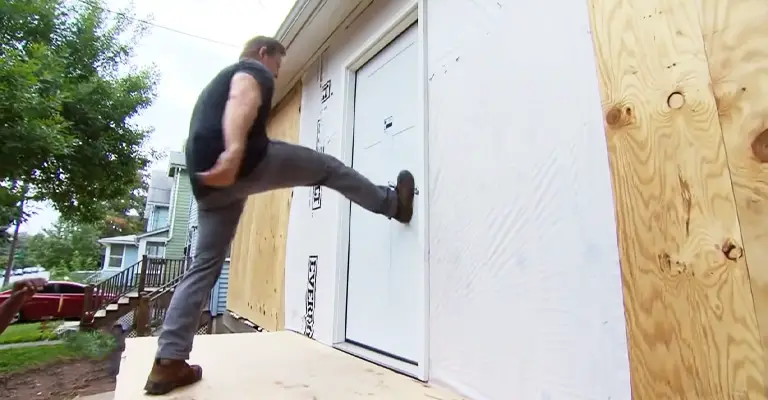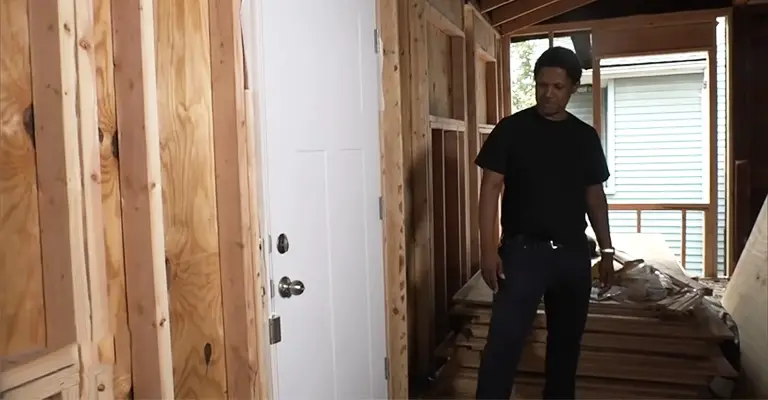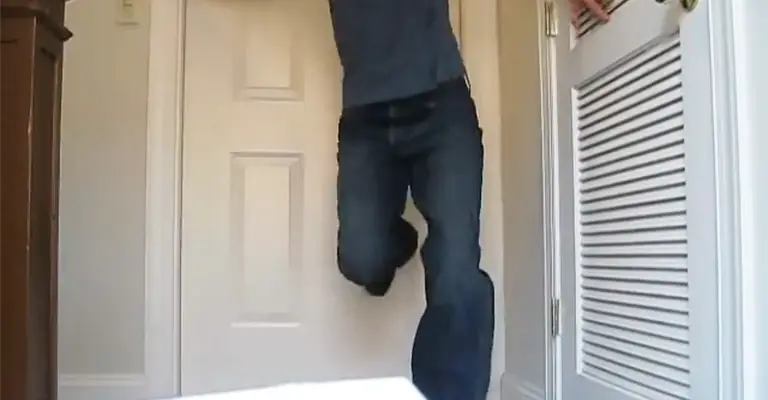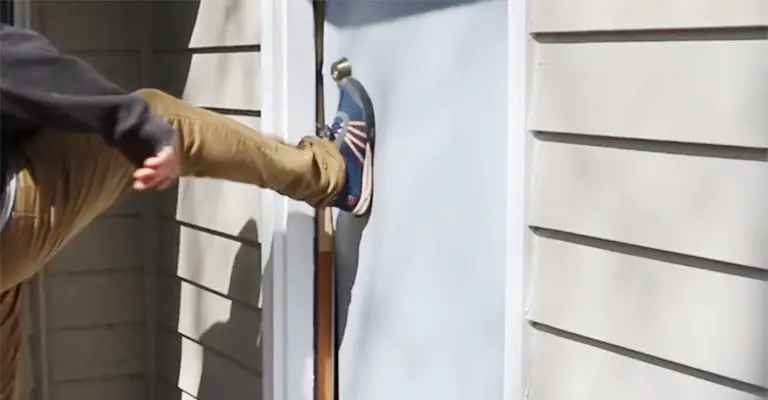When it comes to home security, it’s natural to wonder how easy it is to kick in a door. While it’s true that a determined intruder can gain entry by force, the ease of kicking in a door will depend on a number of factors.
This including the quality and strength of the door and its hardware, as well as the skill and strength of the intruder.
Door frames made from solid-core materials tend to be harder to kick down. For example, solid-core wood doors are usually chipped, shaved, and laminated.
It should be possible to kick down a door or frame made of wood or hollow-core material with minimal force if the material is wood or hollow-core.
While kicking down a door may not be a frequently used skill, it can prove to be highly useful in emergency situations such as fires or medical crises.
It’s crucial to assess the situation and the door before attempting to kick it down. Evaluate whether it’s necessary to do so and if the door is weak enough to break down.
To kick down a door with minimal risk, several steps should be followed, such as examining the door’s materials, locating its weakest point, using forward momentum, and keeping the foot flat during the kick.
How Hard Is It To Kick Open A Door?

In certain situations, kicking down a door may be the only viable solution available to you. This can occur in emergency circumstances, when a family member is trapped, or for various other reasons.
When kicking a door with sheer force is your sole option, it’s vital to understand how to do it safely.
The difficulty of kicking a door down is determined by the door’s material, the weakest point, your stance, angle, and the amount of forward momentum applied.
It is not recommended to kick in a door unless it is the last resort. Additionally, bear in mind that if you do not own the door, you may be liable for any damages incurred.
What Type Of Doors Are The Hardest To Kick Down?

The force required to kick down a door depends on several factors, such as the materials used and the door’s construction. Therefore, it’s crucial to examine the door’s material first to determine if kicking it down is even possible.
When it comes to breaking down doors, wooden ones with a frame and material are generally easier to kick down compared to metal ones. In particular, if the door is made entirely of wood, there is a higher likelihood that it can be kicked in.
Additionally, a hollow core door is also easier to kick down. On the other hand, doors with metal coverings typically have a softwood material inside with iron sheets, making them particularly strong and difficult to break.
Kicking down a door with a hardwood core will also require a lot more effort. Likewise, a hollow metal door is quite robust and heavy.
And in fact, it’s the most difficult type of door to kick in. If a hollow metal door has lock mounting areas, breaking it open becomes almost impossible.
Interior doors, on the other hand, are typically easier to kick in because they are made of lighter materials like fiberboard and hollow types of wood.
Consequently, these doors are generally not as secure as exterior doors, which have a solid core and are made with shaved wood, making them much harder to kick in.
Tips To Kick In A Door

When applying forward force to a door, be cautious not to throw your shoulder into it. Doing so can result in serious injury or even dislocate your shoulder.
Especially if the angle is incorrect. To make it easier to kick in a door, consider the following helpful tips:
Assessing The Door
Before attempting to kick down a door, it’s important to examine the materials of both the door and frame. If the door is constructed of metal or features a metal frame, kicking it down is unlikely to be successful.
Doors or frames made of wood or hollow-core materials are generally easier to kick down, requiring minimal force.
Exterior doors, on the other hand, are typically crafted from solid-core materials such as chipped or shaved wood and laminate, making them harder to kick down.
Hollow-core materials such as hollow wood or fiberboard are commonly used for interior doors. These doors usually lack insulation and security, hence requiring little force to break down.
Doors made from solid hardwood, such as solid wood doors, usually require an average amount of force to kick in.
Metal-clad doors are crafted from softwood with a thin metal layer and require an average to above-average amount of force to kick in.
Hollow metal doors are substantially heavier than other types of doors, and they feature a reinforced channel around their edges and lock mounting area.
Some also have insulating material. Due to their sturdy construction, maximum force may be required to kick them in, and it may even be impossible to do so.
Check The Hinges To See Which Way The Door Swings

Unless the door is constructed from weak materials, kicking it down is only likely to be successful if the door swings away from you.
As hinges are typically situated on the side of the door that swings inward, it’s important to avoid attempting to kick down a door that displays hinges.
Residential exterior doors, such as those found in homes and apartment buildings, usually swing inward. Conversely, many commercial buildings have exterior doors that open outward.
The hinges may need to be removed if the door opens outward. It’s worth noting, however, that many commercial door hinges have theft-proof pins that prevent them from being removed.
Aim For The Door’s Weakest Part

The lock area of the door is typically the most vulnerable part. Therefore, it’s essential to direct your kick towards this area or around the lock. Other parts of the door that may be vulnerable include the frame and the bolt.
While kicking the door, avoid aiming directly for the lock. Instead, focus on the area above or beneath it, as these areas tend to be weaker. Directly kicking the lock can potentially cause injury or damage to your foot.
To deliver multiple kicks, keep your foot flat against the door when striking it. This not only makes it easier to kick down the door but also helps prevent serious injuries.
Timing Of The Kick
It’s important to keep in mind that knocking down a door may require more than one kick. Two, three, or even several kicks may be necessary.
However, it’s crucial to act quickly and deliver subsequent kicks with the required force. Timing is therefore a crucial factor to consider.
Position And Angle Of The Kick
Simply kicking a door without proper technique will not lead to success. Knowing where to kick is essential, but understanding how to kick is even more important. With the right method, kicking in a door can be made much easier.
When facing the door, take 2-3 steps back and then one step forward to build momentum.
Ensure that your non-dominant leg is firmly planted on the ground before driving your dominant heel into the door, landing it next to, just above, or below the door latch.
To produce a powerful kick, keep your knee slightly bent and your feet flat on the ground. Throughout the process, maintain a firm footing with your non-dominant leg to avoid losing balance while kicking.
Sufficient room is necessary for building up enough force for the kick. Make sure to stand according to your leg length, and if your leg is too long, take a couple more steps back.
Be Attentive To Sounds When Kicking
Determining the solidity of the door by listening to the impact is a useful technique to assess the success of your kick.
If you hear a dull and muted sound, it suggests that the door is likely to have a sturdy construction with reinforced materials. In such a scenario, it might be challenging or even impossible to break the door down.
However, if you hear a cracking or breaking sound, it indicates that the door doesn’t have any reinforcing materials, and it’s vulnerable to break down. In this case, you can continue kicking until the door finally falls.
Final Words
Breaking down a door should only be considered as a last resort in emergency situations. However, if necessary, with the right approach, it can be achieved successfully.
Kicking in a door may be a quicker and easier option than trying to unlock it but should only be attempted with caution. It’s crucial to keep in mind the proper technique while attempting to kick down a door.
Maintaining a stable stance, generating adequate momentum, and hitting the right spot are essential for success. It’s also important to prioritize safety and avoid any injuries during the process.






